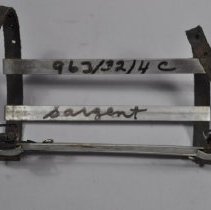Object Record
Images

Metadata
Object ID # |
1963.032.006 |
Object Name |
Restraint |
Title |
Kilkare Device for Baby |
Lexicon category |
5: T&E For Science & Technology |
Date |
1910 patent |
Year Range from |
1910 |
Made |
Kilkare Manufacturing Company |
Place of Origin |
Owen Sound, Grey County |
Description |
This is one of a group of four aluminum and leather arm restraints in the collection. These were called "Kilkare" devices. Each device consists of two buckled leather straps and four aluminum-looking splint bars. The bar ends are folded in order to hold the leather parts. The buckles are black-finished. The patent date is impressed on one side of each splint bar. The leather strapping has a six-hole adjustment. Each device has a short leather strap. At the end is a brass? or metal piece impress-stamped with "OK". The presence of some safety pins suggests that they were needed or were used in the past to help secure the devices to the clothing of the child wearing them? |
Provenance |
Patented in 1910. Manufactured at 1099 1st Ave. West, in Owen Sound, Grey County by the Kilkare Manufacturing Company owned by J. K. McLauchlan. Provenance unknown. Last owned by Roma Sargent (née McClean) of Owen Sound, Grey County. She most likely obtained it in Owen Sound. |
Collection |
Personal Gear |
Material |
Aluminum/Leather |
Found |
Owen Sound, Grey County |
People |
McLauchlan, Joseph Kent Sargent, Roma |
Subjects |
Owen Sound Industry Child behavior Child rearing Children Childhood & youth |
Search Terms |
Kilkare Manufacturing Company Owen Sound Industries and Products |
Function |
A type of splint attached around to a young child's arm to make it impossible for the child to bend its arm to place anything into its mouth that it shouldn't, thus preventing choking hazards like pins, buttons, etc. from getting into the child's airway. They also prevented a child from scratching facial sores, or rubbing their eyes. Also, the devices were advertised as being useful for curbing unwanted behaviours such as thumbsucking and lefthandedness. |

